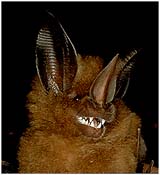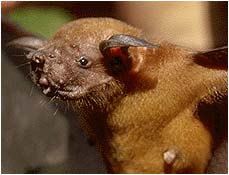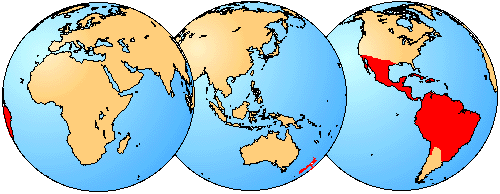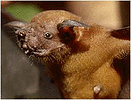Noctilionoidea
Nancy B. Simmons and Tenley Conway


This tree diagram shows the relationships between several groups of organisms.
The root of the current tree connects the organisms featured in this tree to their containing group and the rest of the Tree of Life. The basal branching point in the tree represents the ancestor of the other groups in the tree. This ancestor diversified over time into several descendent subgroups, which are represented as internal nodes and terminal taxa to the right.

You can click on the root to travel down the Tree of Life all the way to the root of all Life, and you can click on the names of descendent subgroups to travel up the Tree of Life all the way to individual species.
For more information on ToL tree formatting, please see Interpreting the Tree or Classification. To learn more about phylogenetic trees, please visit our Phylogenetic Biology pages.
close boxIntroduction
The superfamily Noctilionoidea includes four families: Mystacinidae, Noctilionidae, Mormoopidae, and Phyllostomidae. Mystacinidae and Noctilionidae each include one genus and two species, while Mormoopidae contains two genera and eight species (Koopman, 1993). In contrast, Phyllostomidae includes 48 genera and 138 species (Koopman, 1993), making it the third largest family within Chiroptera.
Food preference varies among taxa in Noctilionoidea, with species variably specialized to feed principally on insects, other animals (e.g., rodents, birds, and other bats), nectar, pollen, fruit, or blood. Many of these bats have unusally facial ornimentation, including nose-leafs, leaf-chin flaps, swollen lips and other projections in the labio-nasal region.
Characteristics
All Noctiloinoidea share the following features:- m. hyoglossus originates from lateral basihyal and lateral thyrohyal in two sheets separated by a space.
- clitoris elongated.
Discussion of Phylogenetic Relationships
A close relationship between Phyllostomidae, Mormoopidae, and Noctilionidae has long been recognized (see review in Simmons and Geisler, 1998). Mormoopidae was once considered a subfamily within Phyllostomidae, but Smith (1972) raised it to family level. Available data supports either a sister taxa relationship between Mormoopidae and Phyllostomidae, with Noctilionidae as sister to that clade (Van Valen, 1979; Simmons, 1998; Kirsch et al., In press), or Mormoopidae and Noctilionidae as sister taxa, with Phyllostomidae as sister to them (Simmons and Geisler, 1998).
It is only recently that Mystacinidae has been associated with Noctilionidae, Mormoopidae and Phyllostomidae. Mystacinidae was historically placed with Molossidae and/or Verspertilionidae (e.g., Simmons and Geisler, 1998) but morphological data have been largely inconclusive concerning the exact affinities of this small family. However, immunological data (Pierson, 1986; Pierson et al., 1986) and DNA-hybridization data (Kirsch et al., in press) strongly supported placement of Mystacinidae within Noctilionoidea. Kirsch et al. suggested that Mystacina is the sister-group of all other noctilionoids, a hypothesis which is compatible with available morphological data.
References
Hill, J.E., and J.D. Smith. 1984. Bats: a natural history. Austin: University of Texas Press.
Koopman, K. F. 1983. Order Chiroptera. In Mammal species of the world, a taxonomic and geographic reference, 2nd ed. D. E. Wilson and D. M. Reeder. Washinton, D. C.: Smithsonian Institution Press.
Kirsch, J. A., J. M. Hutcheon, D. G. Byrnes & B. D. Lloyd. 1998. Affinites and historical zoogeography of the New Zealand Short-tailed bat, Mystacina tuberculata Gray 1843, inferred from DNA-hybridization comparisons. Journal of Mammalian Evolution 5(1): 33-64.
Pierson, E. D. 1986. Molecular systematics of the Mircochiroptera: higher taxon relationships and biogeography. Unpublished Ph.D. thesis, University of California, Berkeley.
Pierson, E .D., V. M. Sarich, J. M. Lowenstein, M. J. Daniel & W. E. Rainey. 1986. A molecular link between the bats of New Zealand and South America. Nature 323: 60-63.
Simmons, N. B. 1998. A reappraisal of interfamilial relationships of bats. In Bats: Phylogeny, Morphology, Echolocation and Conservation Biology. T.H. Kunz and P.A. Racey (eds.). Washington: Smithsonian Institution Press.
Simmons, N. B. & J. H. Geisler. 1998. Phylogenetic relationships of Icaronycteris, Archeonycteris, Hassianycteris, and Palaeochiropteryx to extant bat lineages, with comments on the evolution of echolocation and foraging strategies in microchiroptera. Bulletin of the American Museum of Natural History. 235:1-182.
Van Valen, T. A. 1979. The evolution of bats. Evolutionary Theory, 4:104-121.
Title Illustrations

Mimon bennettii (Phyllostomidae) and Noctilio leporinus (Noctilionidae). Copyright © Nancy Simmons 1998
| Copyright |
© 1998 Nancy B. Simmons

|
|---|
| Copyright |
© 1998 Nancy B. Simmons

|
|---|
About This Page
Nancy B. Simmons

American Musuem of Natural History, New York, New York, USA
Tenley Conway

University of Toronto at Mississauga, Ontario, Canada
Correspondence regarding this page should be directed to Nancy B. Simmons at
simmons@amnh.org
Page copyright © 1997 Nancy B. Simmons
 Page: Tree of Life
Noctilionoidea.
Authored by
Nancy B. Simmons and Tenley Conway.
The TEXT of this page is licensed under the
Creative Commons Attribution License - Version 3.0. Note that images and other media
featured on this page are each governed by their own license, and they may or may not be available
for reuse. Click on an image or a media link to access the media data window, which provides the
relevant licensing information. For the general terms and conditions of ToL material reuse and
redistribution, please see the Tree of Life Copyright
Policies.
Page: Tree of Life
Noctilionoidea.
Authored by
Nancy B. Simmons and Tenley Conway.
The TEXT of this page is licensed under the
Creative Commons Attribution License - Version 3.0. Note that images and other media
featured on this page are each governed by their own license, and they may or may not be available
for reuse. Click on an image or a media link to access the media data window, which provides the
relevant licensing information. For the general terms and conditions of ToL material reuse and
redistribution, please see the Tree of Life Copyright
Policies.
Citing this page:
Simmons, Nancy B. and Tenley Conway. 1997. Noctilionoidea. Version 01 January 1997 (under construction). http://tolweb.org/Noctilionoidea/16093/1997.01.01 in The Tree of Life Web Project, http://tolweb.org/










 Go to quick links
Go to quick search
Go to navigation for this section of the ToL site
Go to detailed links for the ToL site
Go to quick links
Go to quick search
Go to navigation for this section of the ToL site
Go to detailed links for the ToL site